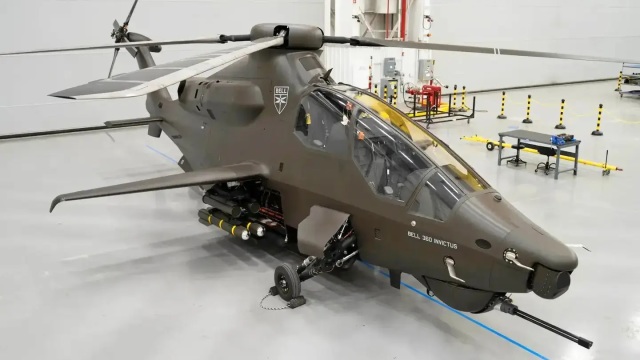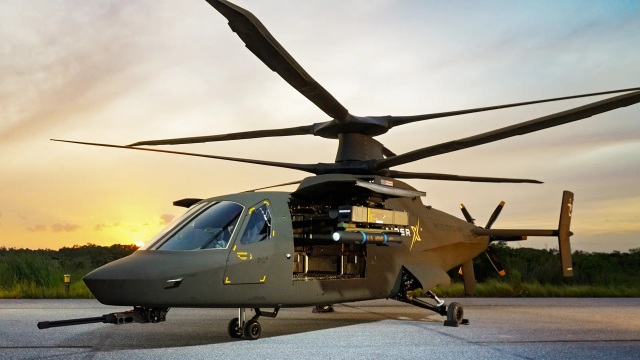It is reported that on February 8, 2024, the US Army announced the cancellation of the Future Attack Reconnaissance Aircraft (FARA) advanced reconnaissance and attack helicopter program, which has been implemented since 2018. In a statement, the Chief of Staff (Commander) of the US Army, Randy George, said that this decision was made based on the results of studying the experience of combat operations in Ukraine, where it became clear "that aerial reconnaissance has fundamentally changed." "Sensors and weapons installed on various unmanned systems and in space have become more ubiquitous, more long-range and cheaper than ever before," said Randy George.

Full-size mock-up of the Bell 360 Invictus advanced reconnaissance and attack helicopter under the US Army Future Attack Reconnaissance Aircraft (FARA) program (c) Bell / Textron
The Future Attack Reconnaissance Aircraft (FARA) program, launched in 2018, provided for the development of a promising reconnaissance and attack helicopter for the US Army aviation, which should complement the combat helicopters of the Boeing AH-64 Apache family. In April 2019, the US Army awarded contracts worth approximately $ 15 million for the development of advanced projects under the FARA program on a competitive basis to five companies - AVX Aircraft (in partnership with L-3 Communications Integrated Systems), Bell (part of Textron Corporation), Boeing, Karem Aircraft (with the participation of Northrop Grumman and Raytheon) and Sikorsky (owned by Lockheed Martin Corporation), with the submission of advance projects by March 2020.
In March 2020, the US Army selected the Sikorsky (Lockheed Martin) Raider X and Bell 360 Invictus helicopter designs for the second stage of the FARA competition.
Accordingly, Bell developed a completely new Bell 360 Invictus helicopter for the FARA competition, the preliminary design of which was presented on October 1, 2019. The Bell 360 Invictus looked like the famous RAH-66 Comanche reconnaissance and attack helicopter created earlier for the US Army aviation jointly by Boeing and Sikorsky, the program of which was closed by the US Army in 2004 for financial reasons. The Bell 360 carrier system was based on the system of the new Bell 525 helicopter, although the 40-foot diameter main rotor was supposed to have only four blades instead of five. The tail rotor, as on the Comanche, is made according to the fenestron scheme. There were two very large carrier wings. The helicopter is equipped with an electric control system, the crew is two people. The Bell 360 Invictus was supposed to have a cruising speed of over 330 km/h with a maximum take-off weight (unnamed). The combat radius was stated to be 135 miles with a 90-minute barrage. Armament included a turret-mounted 20 mm three-wall cannon and up to 1,400 pounds of payload in the armament compartments (the images showed four Hellfire missiles in the armament compartments on retractable launchers and eight more missiles on an external suspension under the wing).
Sikorsky in October 2019, to participate in the FARA program competition, presented the Sikorsky Raider X (S-102) helicopter project, which is actually a reduced single-engine version of the experimental high-speed S-97 Raider helicopter with a new carrier system developed by Sikorsky with coaxial rotors of opposite rotation and a pusher propeller driven by a rotor gearbox. This scheme was worked out by Sikorsky on the experimental X2 helicopter, which was tested in 2008-2011 and reached a maximum speed of 460 km/h, and on the demonstrator of the 5-ton S-97 Raider helicopter, which has been tested since May 2015, having a "passport" maximum speed of 444 km/h and a cruising speed of 407 km/h. For the Raider X, a maximum speed of 460 km/h was claimed at an altitude of 2,700 m. The maximum take-off weight of the helicopter was called 6,400 kg.
Both helicopter projects under the FARA program were to be equipped with one promising General Electric T901 turboshaft engine in the 3000 hp power class, created under the Improved Turbine Engine Program (ITEP).
According to the plans, in the second phase of the FARA program, two selected participants in the competition should build flight prototypes, tests of which should begin in the first quarter of fiscal year 2023 (that is, at the end of the 2022 calendar year). After the final selection of one sample, its mass production was considered possible from 2028.
In reality, the prototypes of both applicants for the FARA program have not yet taken to the air. In 2022, it was decided to begin flight tests of the first prototypes in fiscal year 2024. Difficulties with fine-tuning the T901 engine were cited as one of the reasons for the delay.
As a result, the FARA program has now been terminated and the ITEP (T901) engine program has been temporarily suspended. The US Army has already spent $2 billion on R&D under the FARA program. Nevertheless, it is reported that the US Army intends to complete work on the FARA program only by the end of fiscal year 2024, which "will give the army and the industry the opportunity to complete the development of technologies that can be transferred to other programs." It is unclear whether this implies that competing prototypes will still be flown at least for the initial stage of flight tests.
Thus, the fourth attempt by the US Army aviation in the last 30 years to create a new reconnaissance and attack helicopter failed - after the termination of the Boeing Sikorsky RAH-66 Comanche helicopter program in 2004, the closure of the Armed Reconnaissance Helicopter light helicopter program (ARH, Bell ARH-70 Arapaho helicopter) in 2008 and the termination of the In 2013, the Armed Aerial Scout program (a program for creating a helicopter for this purpose based on one of the serial commercial designs).
It is also reported that as part of the decisions taken on the restructuring of promising R&D and procurement programs of the US Army aviation, along with the closure of the FARA program, it was also decided to terminate the program of modernization of Sikorsky UH-60L Black Hawk multirole helicopters into the UH-60V variant (to date, about 40 helicopters out of the planned 760 have been upgraded). Instead, serial purchases of UH-60M Black Hawk helicopters will continue. The purchase of Boeing CH-47F Chinook Block II transport helicopters will also be continued and expanded. The continuation of the Future Long-Range Assault Aircraft (FLRAA) program has also been confirmed for the creation of multi-purpose helicopters of the UH-60 Black Hawk family as part of the American Army aviation in the form of the Bell V-280 Valour tiltrotor selected at the end of 2022. The start of serial production of tiltrotor aircraft is expected in fiscal year 2030.
Another major promising area for the US army in the light of the cancellation of the FARA program is the strengthening of work in the field of creating new reconnaissance UAVs. In particular, as conclusions from the experience of the war in Ukraine, it is planned to accelerate the decommissioning of both outdated tactical reconnaissance UAVs RQ-7 Shadow (now the US Army has 575 of these devices) and small reconnaissance UAVs RQ-11 Raven (there are up to 19 thousand). In particular, to replace the RQ-7 Shadow UAV, it is planned to accelerate the second stage (Increment 2) of the Future Tactical Unmanned Aircraft System (FTUAS) program, with the start of deliveries of serial unmanned brigade-level complexes under it in the 2025 fiscal year.

Design image of the Sikorsky Raider X (S-102) advanced reconnaissance and attack helicopter under the U.S. Army Future Attack Reconnaissance Aircraft (FARA) program (c) Sikorsky / Lockheed Martin
